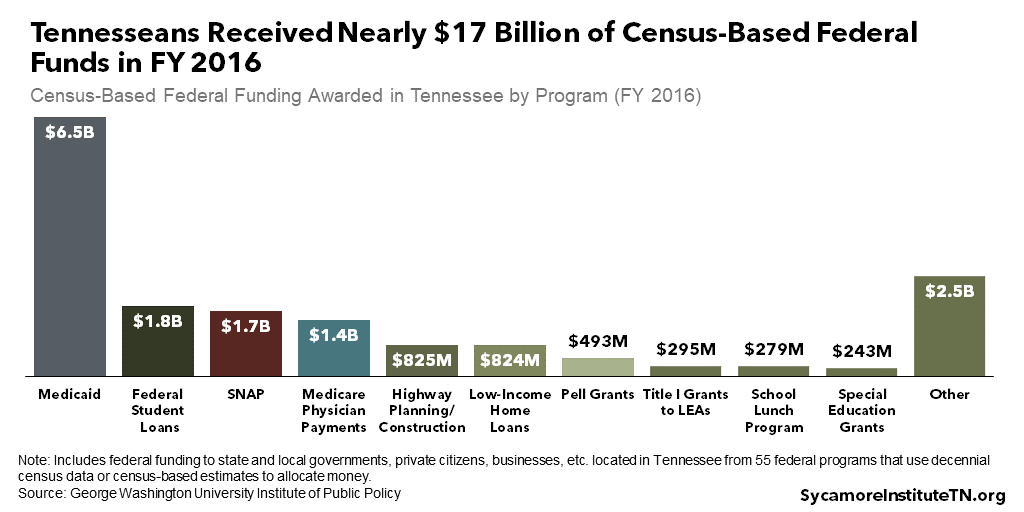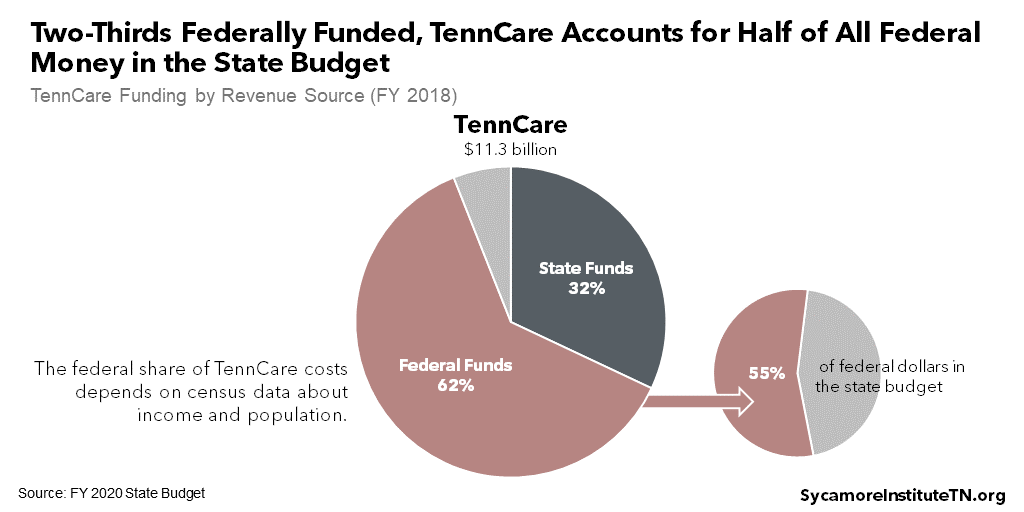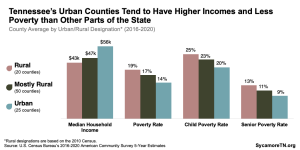
The 2020 census is ramping up across the country. For Tennesseans, an accurate census count helps ensure that we receive our intended share of political representation, resources, and attention from state and federal government. This brief explains the purpose of the 2020 census and four reasons an accurate count is important for Tennessee.
Key Takeaways
- A lot of federal spending in Tennessee depends on census data – including at least $17 billion in FY 2016.
- Census data affect Tennesseans’ voice in federal, state, and local government.
- Tennessee uses census data to calculate how much state tax revenue goes to local governments – an important funding source for counties, cities, and towns.
- The census helps policymakers and organizations use their limited time and resources to serve Tennesseans more effectively.
What Is the Census?
Once a decade, the U.S. Census Bureau counts every person living in the United States. The U.S. Constitution requires a census every 10 years to determine exactly how many people live in each state. (1) In addition to population level and location, the census gathers information about age, sex, race/ethnicity, household size, and housing type. (2)
This precise count serves as the basis for annual estimates of population and demographic change. Each year until the next census, the federal government updates its population estimates using the most recent census as the starting point. (3) The census also informs estimates based on annual surveys like the American Community Survey. If the census is inaccurate, these annual updates and estimates will also be less accurate.
Figure 1

Four Reasons the 2020 Census Matters for Tennessee
The 2020 census and subsequent annual estimates based on it will be used to allocate taxpayer resources, redraw legislative districts, and inform countless policy decisions over the next decade.
1. A lot of federal spending in Tennessee depends on census data — including over $29.6 billion in FY 2017.
Census data affect how the federal government allocates more than $1.5 trillion through 300+ programs. (5) A detailed breakdown of federal FY 2017 spending in Tennessee is not yet available. (4) However, data from FY 2016 show just 55 of those programs accounted for nearly $17 billion in federal funds flowing to Tennessee — including individuals, state and local governments, and Tennesseebased businesses, nonprofits, and organizations (Figure 1). (6) The largest of these programs is Medicaid/TennCare — the single biggest expense and top source of federal dollars in the state budget (Figure 2). (6) The share of TennCare’s costs paid by the federal government depends largely on annual, census-based estimates of population and income.
An accurate census count ensures that Tennessee receives its intended share of federal dollars. For example, the 2010 census undercounted people in Tennessee by an estimated 0.12% — costing the state approximately $7.7 million across just five federally-funded programs in FY 2015. (7) (8)
Figure 2

2. Census data affect Tennesseans’ voice in federal, state, and local government.
Every 10 years, we use census data to update district maps for Congress, the Tennessee General Assembly, and many city and county legislatures. Within-state population shifts typically result in new district boundaries for the U.S. House of Representatives, the state Senate, and the state House. Tennessee is one of 27 states that tasks its state legislature to draw these new boundaries every decade. (9) Local governments in Tennessee also use the census to draw district boundaries for their governing bodies. (10)
The census determines how many votes Tennessee has in Congress and the Electoral College. Tennessee currently has nine U.S. House seats and 11 electoral votes for president. The 2020 census is not expected to change those numbers. (9) Regardless of population, every state has two U.S. senators
3. Tennessee uses census data to calculate how much state tax revenue goes to local governments.
The state shares over $1.2 billion in tax revenue with local governments each year, much of it based on population. These state-shared taxes are an important funding source for county and municipal governments. For example, Tennessee distributed $378 million in gas and fuel taxes to local governments in FY 2018 for roads and highways. Each city or town’s share of that money depended on its population, while population and land area combined determined half of each county’s portion. (6)
4. The census helps policymakers and organizations use their limited time and resources to serve Tennesseans more effectively.
Policymakers often rely on census data to understand their communities, set priorities, and craft policy. Governments at all levels use census data to inform how and where to spend their limited time and funding. For example, insights into local populations and characteristics can help to prioritize public dollars between schools, fire departments, roads, and green spaces.
A wide array of organizations and individuals outside of government also use census data for research and decision-making. Researchers, for example, rely on accurate data to understand issues and test solutions. (11) Likewise, businesses and nonprofits use census data to research where to invest their time and resources. Knowing who lives where allows us to more accurately estimate things like market size, labor pools, and local needs and preferences.
Parting Words
The 2020 census will have huge effects on Tennessee in the coming decade — both direct and indirect. It affects our political representation at every level of government, how much taxpayer money flows where, and the ability of public and private sector actors to make well-informed decisions based on evidence and data. To this end, the governor’s office and many local governments are partnering with the Census Bureau to ensure that an accurate count is taken in Tennessee. (12) To learn more about the importance of an accurate census and your role in it, visit 2020census.gov.
*This brief was updated on Feb. 21, 2020 to add new information about FY 2017 federal funding.
References
Click to Open/Close
- United States Constitution. Art. 1, Sec. 2. [Online] https://www.archives.gov/founding-docs/constitutiontranscript.
- US Census Bureau. Questions Asked. [Online] https://2020census.gov/en/about-questions.html.
- O’Hare, William P. The Importance of Census Accuracy: Uses of Census Data. Differential Undercounts in the U.S. Census. Cham : Springer International, 2019. https://link.springer.com/chapter/10.1007/978-3-030-109738_2
- Reamer, Andrew. Brief 7: Comprehensive Accounting of Census-Guided Federal Spending (FY2017). George Washington Institute of Public Policy. [Online] November 2019. https://gwipp.gwu.edu/sites/g/files/zaxdzs2181/f/downloads/Counting%20for%20Dollars%202020%20-%20Comprehensive%20Accounting_Report%207B%20Feb%202020%20rev.pdf.
- —. Brief 7: Comprehensive Accounting of Census-Guided Federal Spending (FY2017). George Washington Institute of Public Policy. [Online] November 2019. https://gwipp.gwu.edu/sites/g/files/zaxdzs2181/f/downloads/Counting%20for%20Dollars%202020%20Brief%207A%20-%20Comprehensive%20Accounting.pdf.
- —. Fifty-Five Large Federal Census-Guided Spending Programs: Distribution by State (Tennessee). George Washington Institute of Public Policy. [Online] May 2019. https://gwipp.gwu.edu/sites/g/files/zaxdzs2181/f/downloads/IPP-1819-3%20CountingforDollars_TN.pdf.
- State of Tennessee. FY 2020 State Budget. [Online] January 2019. https://www.tn.gov/finance/fa/fa-budgetinformation/fa-budget-archive/fa-budget-publication-2019-2020.html.
- United States Census Bureau. 2010 Census Coverage Measurement Person Results for Tennessee. [Online] May 2012. https://www.census.gov/coverage_measurement/pdfs/tennessee/st47.pdf.
- Reamer, Andrew. Report #2: Estimating Fiscal Costs of a Census Undercount to States. George Washington Institute of Public Policy. [Online] March 2018. https://gwipp.gwu.edu/sites/g/files/zaxdzs2181/f/downloads/GWIPP%20Reamer%20Fiscal%20Impacts%20of%20Census%20Undercount%20on%20FMAP-based%20Programs%2003-19-18.pdf.
- Brennan Center for Justice. 50 State Guide to Redistricting. [Online] June 7, 2019. https://www.brennancenter.org/sites/default/files/2019-09/2019_06_50States_FINAL_1.pdf.
- State of Tennessee Comptroller of the Treasury. A Guide to Local Redistricting in Tennessee (2011 Edition). [Online] 2011. https://www.comptroller.tn.gov/content/dam/cot/pa/documents/lg/GuideToRedistrict.pdf.
- The Council of Economic Advisers. The Use of Census Data: An Analytical Review. [Online] April 2000. https://clintonwhitehouse4.archives.gov/media/pdf/censusreview.pdf.
- United States Census Bureau. 2020 Census Complete Count Committees. [Online] January 30, 2020. https://www.census.gov/library/visualizations/interactive/2020-complete-count-committees.html.
Featured image by Billy Hathorn
















